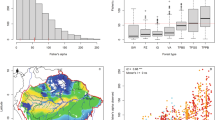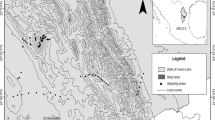Abstract
Knowledge of the spatial distribution of plant species is essential to conservation and forest managers in order to identify high priority areas such as vulnerable species and habitats, and designate areas for reserves, refuges and other protected areas. A reliable map of the diversity of plant species over the landscape is an invaluable tool for such purposes. In this study, the number of species, the exponent Shannon and the reciprocal Simpson indices, calculated from 141 quadrat sites sampled in a tropical forest were used to compare the performance of several spatial interpolation techniques used to prepare a map of plant diversity, starting from sample (point) data over the landscape. Means of mapped classes, inverse distance functions, kriging and co-kriging, both, applied over the entire studied landscape and also applied within vegetation classes, were the procedures compared. Significant differences in plant diversity indices between classes demonstrated the usefulness of boundaries between vegetation types, mapped through satellite image classification, in stratifying the variability of plant diversity over the landscape. These mapped classes, improved the accuracy of the interpolation methods when they were used as prior information for stratification of the area. Spatial interpolation by co-kriging performed among the poorest interpolators due to the poor correlation between the plant diversity variables and vegetation indices computed by remote sensing and used as covariables. This indicated that the latter are not suitable covariates of plant diversity indices. Finally, a within-class kriging interpolator yielded the most accurate estimates of plant diversity values. This interpolator not only provided the most accurate estimates by accounting for the indices' intra-class variability, but also provided additional useful interpretations of the structure of spatial variability of diversity values through the interpretation of their semi-variograms. This additional role was found very useful in aiding decisions in conservation planning.
Similar content being viewed by others
References
Austin, M. P.: 2002, ‘Spatial prediction of species distribution: An interface between ecological theory and statistical modeling’, Ecol. Modell. 157, 101–118.
Borrough, P. A.: 2001, ‘GIS and geostatistics: Essential partners for spatial analysis’, Environ. Ecol. Stat. 8, 361–377.
Borrough, P. A. and McDonnell, R. A.: 1998, ‘Principles of geographical information systems,’ Spatial Information Systems and Geostatistics. Oxford University Press.
Brooker, P. I.: 2001, ‘Modeling spatial variability using soil profiles in the Riverland of South Australia’, Environ. Int. 27 121–126.
Cabrera, C. E., Souza, S. M. and Tellez, V. O.: 1982, ‘Imagenes de la flora quintanaroense’, Centro de Investigaciones de Quintana Roo. Mexico.
Campbell, J. B.: 1987, Introduction to Remote Sensing, The Guilford Press. New York.
Carroll, S. S.: 1998, ‘Modeling abiotic indicators when obtaining spatial predictions of species richness’, Environ. Ecol. Stat. 5, 257–276.
Clark, D. B., Palmer, M. W., and Clark, D. A.: 1999, ‘Edaphic factors and the landscape-scale distributions of tropical rain forest trees’, Ecology 80(8), 2662–2675.
Crist, E. P. and Cicone, R. C.: 1984, ‘Application of the tasseled cap concept to simulated thematic mapper data’, Photogram. Eng. Remote Sensing 50(3), 343–352.
Earth Resource Mapping Ltd. 1998. ER Mapper 6.1. User guide. San Diego, CA.
French, K.: 1999, ‘Spatial variability in species composition in birds and insects’, J. Insect Conserv. 3, 183–189.
Fuller, R. M., Groom, G. B., Mugisha, S., Ipulet, P., Pomeroy, D., Katende, A. and Bailey, R., and Ogutu-Ohwayo, R.: 1997, ‘The integration of field survey and remote sensing for biodiversity assessment: a case study in the tropical forest and wetlands of Sango Bay, Uganda’, Biol. Conserv. 86, 379–391.
Gao, B. C.: 1996, ‘NDWI –a normalized difference water index for remote sensing of vegetation liquid water from space’, Remote Sensing Environ. 58, 257–266.
Hernandez-Stefanoni, J. L. and Ponce-Hernandez, R.: 2004, ‘Mapping the spatial distribution of plant diversity indices in a tropical forest using multi-spectral satellite image classification and field measurements’, Biodiv. Conserv. 13, 2599–2621.
Isaaks, E. H. and Srivastava, R. M. 1989, An Introduction to Applied Geostatistics, Oxford University press. New York.
Isik, K., Yaltikik, F. and Akesen, A.: 1997, ‘The interrelationship of forests, biological diversity and the maintenance of natural resources’, Unasylva FAO 48, 190–191.
Juang, K. W. and Lee, D. Y.: 1998, ‘A comparison of three kriging methods using auxiliary variables in heavy-metal contaminated soils’, J. Environ. Qual. 27, 355–363.
Kravchenco, A. and Bullock, D. G.: 1999, ‘A comparative study of interpolation methods for mapping soil properties’, Agron. J. 91, 393–400.
Krebs, C. J.: 1989, Ecological Methodology, New York.
Legendre, P.: 1993, ‘Spatial autocorrelation: Trouble or new paradigm?’, Ecology 74(6), 1659–1673.
Lyon, J. G., Yuan, D., Lunetta, R. S. and Elvidge, C. D.: 1998, ‘A change detection experiment using vegetation indices’, Photogram. Eng. Remote Sensing 64(2), 143–150.
Magurran, A. E.: 1988, Ecological Diversity and its Measurement. Princeton University Press, Princeton, NJ.
Moreno, C. E. and Halffter, G.: 2001, ‘Spatial and temporal analysis of α, β, and γ diversities of bats in a fragmented landscape’, Biodiv. Conserv. 10, 367–382.
Myers, N., Mittermeier, R. A., Mittermeier, C. G., da Fonseca, G. A. B. and Kent, J.: 2000, ‘Biodiversity hotspots for conservation priorities’, Nature 43(24), 853–858.
Nagendra, H. and Gadgil, M.: 1999, ‘Satellite imagery as a tool for monitoring species diversity: An assessment’, J. Appl. Ecol. 36, 388–397.
Nalder, I. A. and Wein, R. W. 1998, ‘Spatial interpolation of climatic normals: Test of a new method in the Canadian boreal forest’, Agricult. For. Meteorol. 92, 211–225.
National Aeronautics and Space Administration. 1998, Landsat 7 science data users handbook Greenbelt, Maryland, Goddard Space Flight Center, electronic version http://ltpwww.gsfc.nasa.gov/IAS/handbook/handbook_toc.html.
Noss, R. F.: 1990, ‘Indicators for monitoring biodiversity: A hierarchical approach’, Conserv. Biol. 4(4), 355–364.
Palmer, M. W., Clark, D. B. and Clark, D. A.: 2000, ‘Is the number of tree species en small tropical forest plots nonramdom?’, Comm. Ecol. 1(1), 95–101.
Pitkanen, S.: 1998, ‘The use of diversity indices to assess the diversity of vegetation in managed boreal forest’, For. Ecol. Manage. 112, 121–137.
Plotkin, J. B., Potts, M. D., Yu, D. W., Bunyavejchewin, S., Condit, R., Foster, R., Hubbell, S., LaFrankie, J., Manokaran, N., Lee, H. S., Sukumar, R., Nowak, M. A. and Ashton, P. S.: 2000, ‘Predicting species diversity in tropical forests’, Proc. Nat. Ac. Sci. 97(20), 10850–10854.
Ponce-Hernandez, R.: 1994, ‘Improving the representation of soil spatial variability in geographical information systems: A paradigm shift and its implications’, in: International Society of Soil Science, 1994. 15th World Congress of Soil Science. Volume 6a. Acapulco, Mexico.
Prudhomme, C. and Reed, D. W.: 1999, ‘Mapping extreme rainfall in a mountainous region using geostatistical techniques: A case study in Scotland’, Int. J. Climatol. 19, 1337–1356.
Riemann, H. R.: 1996, ‘Understanding the spatial distribution of tree species in Pennsylvania’, in: Mowrer, H. T. (ed), ‘Spatial Accuracy Assessment in Natural Resources and Environmental Sciences’. Second International Symposium. General Technical Report. RM-GTR-277. Fort Collins, CO. USDA Forest Service, Rocky Mountain Forest and Range Experiment Station, pp. 73–82.
Robertson, G. P.: 1987, ‘Geoestatistics in ecology: Interpolating with known variance’, Ecology 68(3), 744–748.
Robertson, G. P.: 2000, GS+: Geostatistics for Environmental Science. Gamma Design Software. Plainwell, Michigan.
Rossi, R. E., Mulla, D. J., Journel. A. G., and Franz, E. H.: 1992. ‘Geostatiscal tools for modeling and interpreting ecological spatial dependence’, Ecol. Monogr. 62, 277–314.
Stein, A.: 1992, ‘The use of prior information in spatial statistics', in: De Gruijter et al. 1994. Pedometrics’92. Proceedings of the First Conference of the Working Group on Pedometrics of the International Society of Soil Science. Wageningen, The Netherlands.
Voltz, M. and Webster, R.: 1990, ‘A comparison of kriging, cubic splines and classification for predicting soil properties from sample information’, J. Soil Sci. 41, 473–490.
Wagner, H. H., Wildi, O., and Ewald, K. C.: 2000, ‘Additive partitioning of plant species diversity in an agricultural mosaic landscape’, Landscape Ecol. 15, 219–227.
Wallace, C. S. A. and Watts, J. M. and Yool, S. R. 2000, ‘Characterizing the spatial structure of vegetation communities in the Mojave desert using geostatistical techniques’, Comp. Geosci. 26, 397–410.
Wallerman, J., Joyce, S., Vencatasawmy, C. P., and Olsson, H.: 2002, ‘Prediction of forest steam volume using kriging adapted to detect edges’, Can. J. For. Res. 32, 509–518.
Wilcox, B. A.: 1995, ‘Tropical forest resources and biodiversity: The risk of forest loss and degradation’, Unasylva FAO 46(181).
Zhang, R., Shouse, P., and Yates, S.: 1997, ‘Use of pseudo-crossvariograms and cokriging to improve estimates of soil solute concentrations’, Soil Sci. Soc. Am. J. 61, 1342–1347.
Author information
Authors and Affiliations
Corresponding author
Rights and permissions
About this article
Cite this article
Hernandez-Stefanoni, J.L., Ponce-Hernandez, R. Mapping the Spatial Variability of Plant Diversity in a Tropical Forest: Comparison of Spatial Interpolation Methods. Environ Monit Assess 117, 307–334 (2006). https://doi.org/10.1007/s10661-006-0885-z
Received:
Accepted:
Issue Date:
DOI: https://doi.org/10.1007/s10661-006-0885-z




